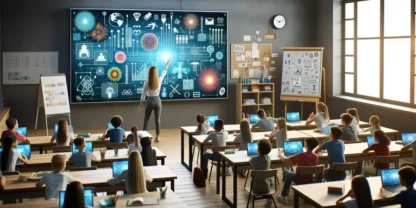Kids are fascinated by everything – except the task at hand. One of the hardest parts of being a teacher is keeping a class full of students engaged. Most teachers have a hard enough time engaging students individually or in small groups with traditional classroom management strategies, much less when there are 20-30+ kids learning together as one. If you lose the attention of a few students, they risk falling behind. You also risk losing the focus of the entire class if these distracted kids pull away the attention of their peers.
Fortunately, there are a few tools you can pull out of your box to regain the attention of your students and hold it – even during the most challenging of lessons. Tap into these classroom management strategies to keep students focused and on task.
How to Get Attention Initially
Gaining attention is essential throughout the school day. Your students will enter and leave the classroom to eat lunch, play at recess, and participate in various electives (like music and art). These activities can help students settle back into the classroom environment and focus their attention on you.
Tap Into Student Interests
It’s not easy to keep up with every fad and trend that your students are obsessed with, but if you can stay on top of most of them, you can get their interest. Begin a lesson with a popular song, toy (like slime), or video that students love. They will enjoy the mental break of engaging with something they care about. Then direct that content toward the lesson. Yes, this is just as simple as playing Baby Shark before introducing a marine biology subject.
Introduce Concepts With Warm-ups
Warm-ups are popular classroom management strategies because they allow students to share what they know or want to learn about before a teacher dives into a lesson. If you are having a hard time getting your students to pay attention, consider choosing a game-based warm-up.
For example, go around the room and ask students to share one word related to a topic. Or state a series of true or false statements and ask students to move from one side of the room to the other based on what they agree with.
Change the Classroom Experience
You can win over the attention and curiosity of students with small changes to the classroom. For example, ask students to sit on top of their desks for a warm-up activity. Let students sit in a circle on the floor for a read-aloud. Place students in pairs or groups.
These small actions will engage students and leave them wondering what sort of activities or lessons you have up your sleeve.

How to Hold Attention When You Have It
There are some days when you will hold the attention of your students and other days when you won’t be able to keep them focused on you. If you are worried that your students will be easily distracted, build these elements into your lesson plans to keep them engaged.
Focus on the Why
For many students, “because I said so,” isn’t a good enough reason to pay attention. Your kids want to know why it is important to learn something or how information is relevant. Try to start each lesson with why your kids need to know this information – and keep coming back to the why. You might be surprised how introducing concepts as tools students can use in the future will motivate them to pay attention.
Connect Students to Real World Problems
If you aren’t sure how to build the “why” into the lesson plan, connect the material to real-world issues. For example, why do students need to know the difference between area and perimeter? Build a case for a park clean-up where a volunteer organization learns how many helpers or trash bags they need based on these concepts.
Project-based learning and real-world connections can engage students in the material and hold their attention.
Set Up Your Supplemental Materials Ahead of Time
Almost every teacher has tried to play a video or load a website, only to have it crash or play without sound. Even the most tech-savvy instructors have breakdowns from time to time. However, do your best to make sure all of your media is loaded and ready to play at the start of the lesson. When you have tech issues, you will lose your students. They will start chatting with each other or their minds will wander away from the lesson.
How to Regain Attention When You Lose It
When you lose your students, you lose valuable class time – and these minutes add up. Even if you only have to regain the attention of your learners a few times a day, you could find yourself without enough time to complete all of the lessons and activities you needed to. Here are a few classroom management strategies to bring students back.
Direct Attention With an Instrument
Your ultimate goal is to not yell over your students. Not only is this frustrating for you, but it can bring up trauma from home in some of your learners.
Consider investing in a small xylophone, bell, or another instrument to play when you need students to give you their attention. Use this to transition from one subject to the next and to signal beginnings and ends. This way, your students associate the sound with positive events, not just as an attention-getting noise.
Turn off the Lights
This is another popular option used by teachers who don’t want to yell over their students to gain their attention. By turning off the lights, students immediately realize something is different and you need their attention. Some teachers also flicker the lights instead of turning them off all the way.
Use Call and Response
With call and response, you start with a call that could include a hand clap pattern, a noise you make, or a phrase you say. Your students respond with a corresponding clap, found, or phrase. To regain student attention, start with your call and expect only a few students to respond. Then call again. As more students realize that they need to respond, the focus of the class will return to you.
Consider changing up the calls and responses every month or incorporating holiday calls (like wolf howls on Halloween) to make the responses fun for students.
Provide Unexpected Rewards
In a classroom full of unruly students or kids who aren’t paying attention, you might still have a few students who are focused on you. When this happens reward the positive behavior. If you have a reward system in your class, give those students faux currency or points for paying attention. Your rewards can also be mini candy bars or extra free time.
The goal of rewards in classroom management strategies is to direct students toward positive behavior and incentivize them to make good decisions.
How to Give Up Attention When You Don’t Need It
The final step in building attentive students is to let your kids focus on other things throughout the day. There is a limited number of minutes any adult or child can focus on something. By giving students breaks, they can release pent-up energy that was preventing them from listening to you.
Let Students Dance
This is a great transition between lessons. Play a song and let students dance around the classroom to the beat. Your students are focused on the music, their dancing, and the moves of their peers. For a few minutes, they don’t have to care about you.
Ask Students to Share Their Thoughts
Another option for classroom transitions is to let students talk amongst themselves for a few minutes after a lesson. They can talk about what they like about a subject and what is challenging. During this time, you can set up the next lesson or ask students to help you clean up supplies and materials from what they just learned.
Create Engagement Stations
If you are reviewing materials or working with small groups of students who need help with specific concepts, keep your other learners engaged with different stations. For example, an extra credit wall is a place where students can complete extra assignments that reinforce the material. It’s okay if students aren’t listening to you at that moment, as long as they aren’t distracting others.
Establish Classroom Management Strategies Early On
Good habits are built over time. Before the school year starts, decide on the best ways to engage students and hold their attention. Establish a call and response plan or invest in a bell to regain lost attention. This way students can adapt to the behaviors that are expected of them from the first day. It is easier to set expectations from the get-go than to change negative behaviors that have already been formed.



